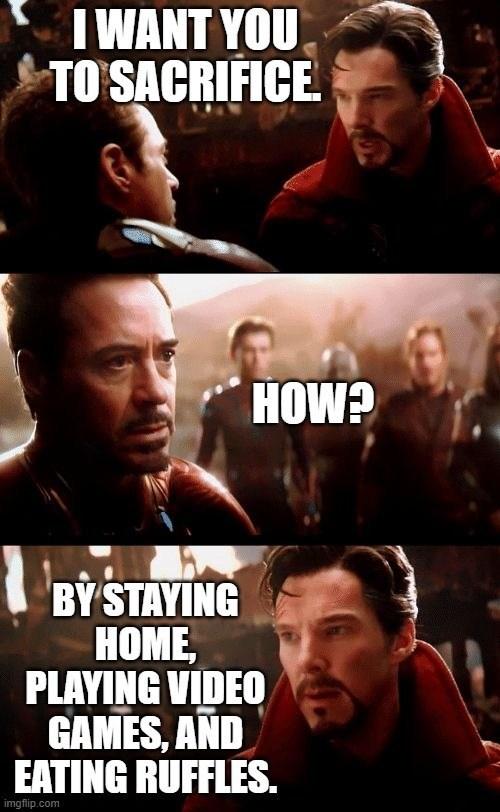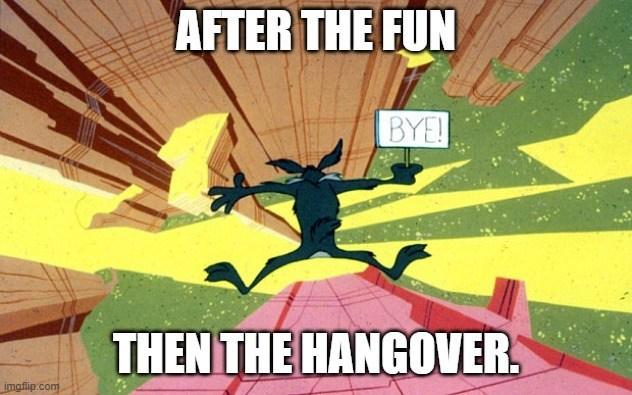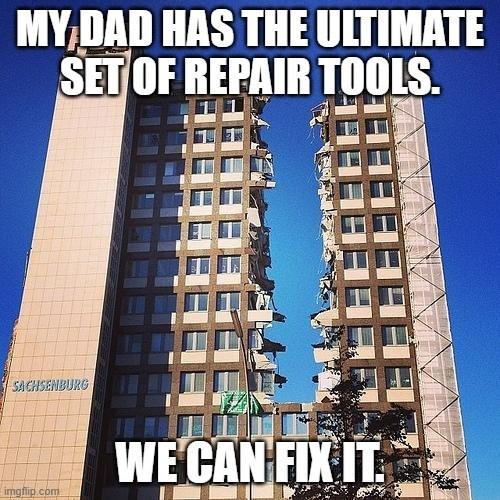The Eight Phases Of Crisis: COVID-19 Edition
I started working from home yesterday, which was nice; but I really do want to talk about COVID-19 and get to the bottom of how the issue will progress in the coming months. While each crisis is different, they are all sort-of-predictable because in the end, people don’t change all that much, even though circumstances do.
But what is this pattern I mentioned? Here are, as near as I can determine, Eight Stages of a Crisis™, a level at which each crisis can be evaluated compared to the other – this is my modification of work originally done by Zunin and Myers. This is like the Kübler-Ross five stages of grief, but with the apocalypse in mind. Why settle for one death, when you can have millions or billions on your mind? It’s so nice and cheery. The nice part of using this model is that you can gauge where we are in the current COVID-19 mess.
1.The Warning
This is the opening stage of a crisis. It may be short, as in 9/11, or it may be a slow-motion collapse like the gradually increasing troop buildups and mobilizations that led to World War I. Everyone wanted to stop it, but no one was sane enough to say “no.” The Warning before the first Civil War was literally decades in length.
In the current COVID crisis, The Warning came during and just after the December impeachment. With the focus of the country elsewhere, who cared about the flu? We don’t trust the media very much. Why? They don’t seem trustworthy. Example: when Trump shuts down air transport to China, CNN® says it’s racist. When China shuts down air transport from the United States, CNN™ says it’s a wise and prudent move by China’s benevolent leadership.
In a world where CNN™ and the Chinese government have similar levels of credibility we tend to forget the ending to the story of the boy who cried wolf: in the end, wolves really attacked.
How did they not see this coming?
2. The Event
The Event is generally not long, but it can be. It’s the Shot Heard Round the World at Lexington and Concord in the Revolutionary War. The Event is when the rules change forever, and nothing can ever make the world go back to the way it was. It’s the spark that lights the fire. When people look back, everyone can see The Event.
Nothing is ever the same afterwards – The Event changes everyone that it touches, and often ends up changing systems permanently. It is disruptive. It may not be the reason that everything fails, it might just be a small event toppling an already unstable system. In a crisis like 9/11, the event is obvious and instant. COVID-19 has led to a slow-rolling avalanche across the economy. Was it poised for a fall anyway? Possibly.
As a longer cascade, what will be The Event that history will use to remember COVID-19?
In one of my more frightening thoughts: what if we haven’t seen The Event yet?
I’m not sure he’s koalafied to make that decision.
3. Disbelief
When things have changed, and changed drastically, people refuse to believe it. When the power is out because a tree fell on the power lines, I will walk into a room an automatically flip the light switch. Why? Habit, partially. But there’s a part of my mind that is existing in Disbelief, perhaps, that doesn’t believe that the power could ever be gone.
Disbelief isn’t a coping strategy, and it’s not an attempt of the mind to protect itself, at least in a healthy person. It’s more inertia. You’re used to the world being a certain way, and when it isn’t, part of your mind isn’t quite ready to process it.
This might be an overreaction – COVID-19 might be no worse than the flu. But that isn’t explained by the reactions we’ve seen so far from places that got it earlier than the United States. Italy is locked down. In two weeks, we will know more. In a month, I think, we will have certainty.
In order to calm panicked customers, Wal-Mart opened up a second register.
4. Panic
At some point, the mind is confronted with the new reality and forced to accept it. But the rules are new, and unknown. What to do? One could take a deep breath, and review the situation and think logically or? One could Panic. Panic is easier, and doesn’t require a lot of thought.
Panic is the natural reaction when your brain realizes that it has done zero to prepare for the new reality. So, what to do? Buy staples as required to build up the stockpile you’ve accumulated over time? Or buy 550 cans of Diet Mountain Dew®? Or just buy toilet paper, because everyone else is and you don’t know what to do or have any independent thought? Toilet paper purchasing is Panic.
Not all heroes are able to walk. I mean, some gained 400 lbs on the couch.
5. Heroism
While the Panic is ongoing, the first glimmer of Heroism starts to show. Brave men and women working in the medical field are the first signs of Heroism. Donald Trump talking with Al Sharpton to address the problems he sees is Heroism – realizing that there is a greater good, and that sacrifice is required. Heroism is embodied throughout the response to the crises where a few have an opportunity to save many, and where enemies put aside squabbles for a time because it’s the right thing to do.
There was a family story – Grandma Wilder went during World War II to weld Liberty ships at the Alameda Ship Yard. She would regularly get things sent to her from her mother who lived in the country in the middle of Flyover. Needles were rationed in San Francisco, but not in Flyover. Sugar was rationed in San Francisco, but not in Flyover. Why ration needles and sugar? To build common purpose, so even people not piloting P-51s or jumping out of landing craft at Iwo Jima could feel like they were doing their part. To be fair, rationing was necessary in wide segments of the economy, it wasn’t a fake, but it did help bring everyone together.
Right now Heroism is going on, and we aren’t even asked to do anything more than to sit down and watch Netflix® unless we’re keeping vital industries going. Here’s a link to Aesop’s place that shows the quiet heroism going on out there (LINK). Read it all.
I read the other day that coyotes are about 10 miles an hour faster than road runners. My entire childhood was a lie.
6. The Cliff
Keeping order requires energy. Some part of the energy of the system is put into keeping order. In a time of significant social cohesion, like World War II, the United States didn’t face The Cliff, even though virtually every other developed nation did. Instead, the energy that the crisis took was replaced by people working together.
Most of the time in a real crisis, however, there’s The Cliff. I wrote about it here: Seneca’s Cliff and You.
We have not fallen off The Cliff. Is it certain that there is one? No. But every single leader, elected or appointed, is acting like it’s there. I believe we will see it. The new normal will be grow from events moving quickly. Already at Wilder Redoubt, we’ve had nothing but home cooked meals for the last week, with a couple of store-bought sandwiches being the exception.
Will home cooked food, family dinners, and homeschooling be the legacy of COVID-19?
I expect that we’ll see The Cliff soon enough. How deep will it go? As I’ve mentioned before, no one knows. The worst case is that the economy crashes through levels to Great Depression era lockup in two weeks or so. Only 40% of Americans are able to absorb an unexpected $1,000 expense. 80% are living paycheck to paycheck, and those paychecks just stopped.
Dead.
Going first will be car payments. The average monthly car payment is $800. Me? I’d sell you my daily driver for just two months of that, so expect car finance companies to seize up like an ungreased stripper pole. But the businesses that employ those people aren’t much better off. The best restaurant in Modern Mayberry came pretty close to closing down shop six years ago, but pulled through. The second best restaurant didn’t survive. There will be cascading failures as the debts owed from one business to the next go unpaid, and this won’t just be for small businesses. I feel confident saying that several businesses with 10,000 or more employees will go bankrupt. Overall loss to the economy? 40% of the GDP this year?
Is there a better case? Sure. We contain COVID-19 in a month or so, and then call it good. We only lose 10% to 20% of our GDP this year, and government pumps five or six trillion dollars into the economy to juice it back up. That’s the best case. And that’s just in the United States.
I’m not kidding, that’s how deep The Cliff is. If we’re lucky.
Something, something, Dark Side®.
7. Disillusionment
After the fall, things suck. We had heroes, but the time for Heroism is over. Disillusionment sets in when things don’t snap back to normal. Things will seem rosy, only for failure to crush hope. The more government “helps” during this phase, the worse recovery will be. Roosevelt “helped” so much during the Great Depression that he extended it for years.
But politicians will take drastic steps, because they can’t help themselves. The length of time Disillusionment lasts? Months to years.
Some re-assembly required.
8. Rebuilding
This is the other side of The Cliff. Whereas, as Seneca said you go down a cliff pretty quickly, you only build up slowly. Rebuilding the economy will take years. If we do it right, we’ll build a stronger economy, less dependent upon foreign supply lines, that guarantees freedom while preserving the traditional values that built the wealth in the first place.
If done poorly? The system is controlled, oppressive, and coercive. Leaders matter, but the quality of the citizenry to fight back against the system is even more important. Rebuilding takes years, and by my best case scenario, four to eight years.
So, I guess I’ll get a jump start on rebuilding.
Tyler Durden
Fri, 04/10/2020 – 12:55








